DC-10 - Around The World In Six Days: A Mad Voyage Chasing An Old Airplane

The latest updates are at the top; scroll to the end of the story to read earlier dispatches.
Day 6 - Wednesday - Tokyo to New York, Oct. 23
The around the world adventure is about to end. We are two and a half hours away from New York's JFK airport, after crossing the North Pacific east of the Russian peninsula of Kamchatka, traversing Alaska flying slightly north of Anchorage, and cutting across Canada from Yukon to Ontario, over which we are currently flying.
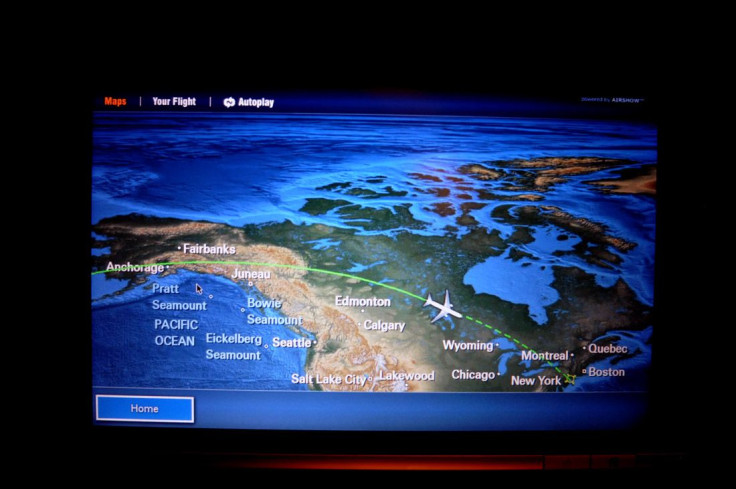
My fellow passengers and I on Japan Airlines flight 6 are about to see a second sunrise today, racing as we are across the night toward the rising sun. We've seen it set to our left a couple of hours after leaving Tokyo in the morning, another weird aspect of flying eastbound across the international dateline at such a high latitude.
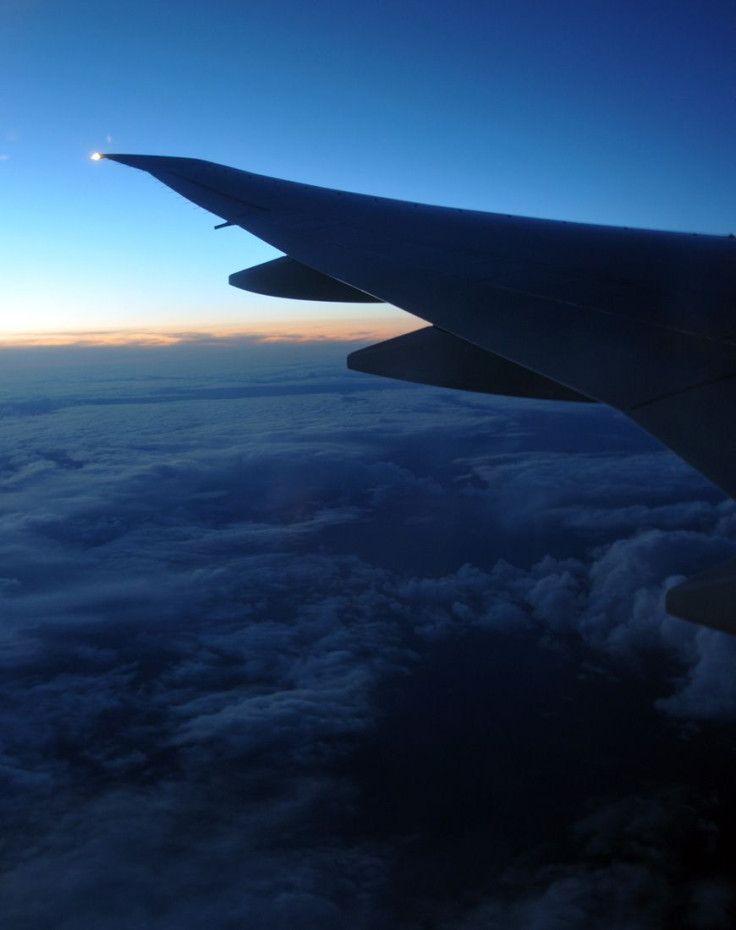
And as I write, a peek out the window reveals that, indeed, the sun is rising. It's 8am local time.
If you have followed so far, you'll know that the adventure of going around the world in six days (five and a half, really, since I left JFK on Thursday last week at 11pm) was based on the attempt to fly the last DC-10 before its sole remaining operator, Biman Bangladesh Airlines, retires it at the end of the year. And you'll know that it didn't happen, as a scheduling change by the airline sent the classic airplane I wanted so badly to a different destination.
But that seems to matter very little right now, at the end of a dash across the globe that has taken me to London, Abu Dhabi, Dhaka, Hong Kong and Tokyo. Airplanes, whether old-school giants from the 1970s like the DC-10 or ultramodern wonders like the Boeing 777 I'm on, with its digital cockpit and enormous General Electric engines (fun airplane-geek fact: the two keeping us in the air right now at just a dash under 700mph are GE90s, the most powerful in the history of aviation), are after all just very convenient means of getting there fast.
Or of putting people together in ways that before the jet age, before machines like my now-lost DC-10 appeared, would have been impossible. Take the couple in row 23 ahead of me, an American man and a Japanese woman with a daughter of about three who loves playing peek-a-boo with me from her seat. Before jets made once-epic journeys like Tokyo to New York a trivial affair, before one could cross the Pacific Ocean in 12 hours rather than the 22 days it took Jules Verne's Phileas Fogg, their story would have been pretty much impossible. Taking the kid back and forth to see each side of the family would have been unthinkable.
Yet here they are, two people from once cosmically distant nations, with their cute sweet daughter and an airline ticket that got them ten thousand kilometers in the air for a price that, in inflation-adjusted terms, has dropped by more than 50 percent since DC-10s started plying the skies. And now, we can even do things like post stories on the internet from seat 24A on an airplane 35,000 feet above the Great Lakes.
Day 6 - Wednesday - Hong Kong to Tokyo, Japan, Oct. 23
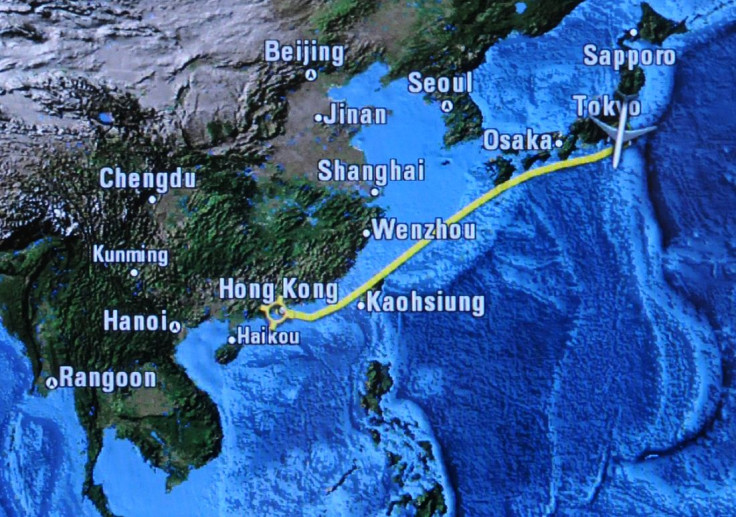
At 6:30am on Wednesday morning, Tokyo's Narita airport looks nothing like one of the busiest in the world. In the international connection area where I am writing with the computer in my lap, after arriving from Hong Kong and before the internet café opens, there is scarcely anybody else around. The last leg of trip my round the world in six days begins in five hours with a 13-hour flight to New York over the North Pacific, Alaska and Canada. And it ends at exactly the same time, 11am on Wednesday, thanks to the magic of the international date line: our scheduled flight time is precisely equal to the time zone difference between Tokyo and New York.
Tuesday was spent mercifully sleeping from 6am to 1 pm on very comfortable pillows, a rare occurrence since I started last Thursday from New York, at a Hong Kong hotel -- and in the afternoon, exploring the neighborhood of Tsim Sha Tsui in search of good noodles and photo opportunities. I found both.
Hong Kong, even for a first-timer in the city, feels familiar if you happen to be a New Yorker. It seems to run on the same business-all-the-time vibe; its people walk with the same no-nonsense air of purpose; and even a quick visit to the waterfront will tell you that it exists for the same reason New York does -- it's a commerce hub built by traders around a perfect natural harbor. Not by chance did that other traveler around the world, Jules Verne's Phileas Fogg, pass through here too, headed to Japan.
The won ton noodles I ate off Carnarvon Road, following the principle learned in New York's Chinatown that you should home in on places where nobody is Western, were a delight. The stroll that followed them convinced me that Hong Kong would feel pretty much like home to the average New Yorker, except for one thing: the throat-choking smog. I did not have to resort to the cardboard cutouts of the panorama of Victoria Harbor that some tourists have been known to photograph when the haze is too thick to see much, but the smog was visibly bad. The setting sun and some jockeying among the many tourists saved the day.
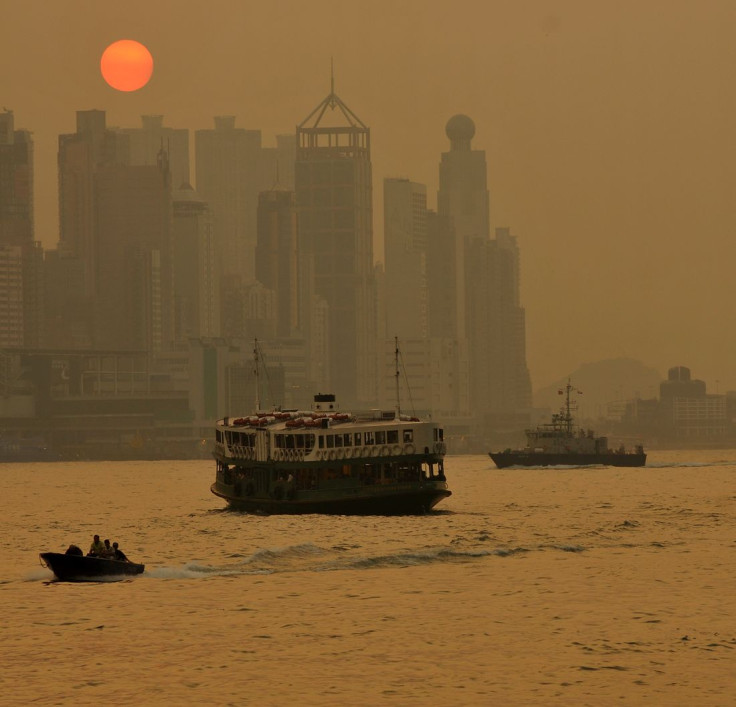
And it's good to know that the smog wasn't enough to deter this happy couple.
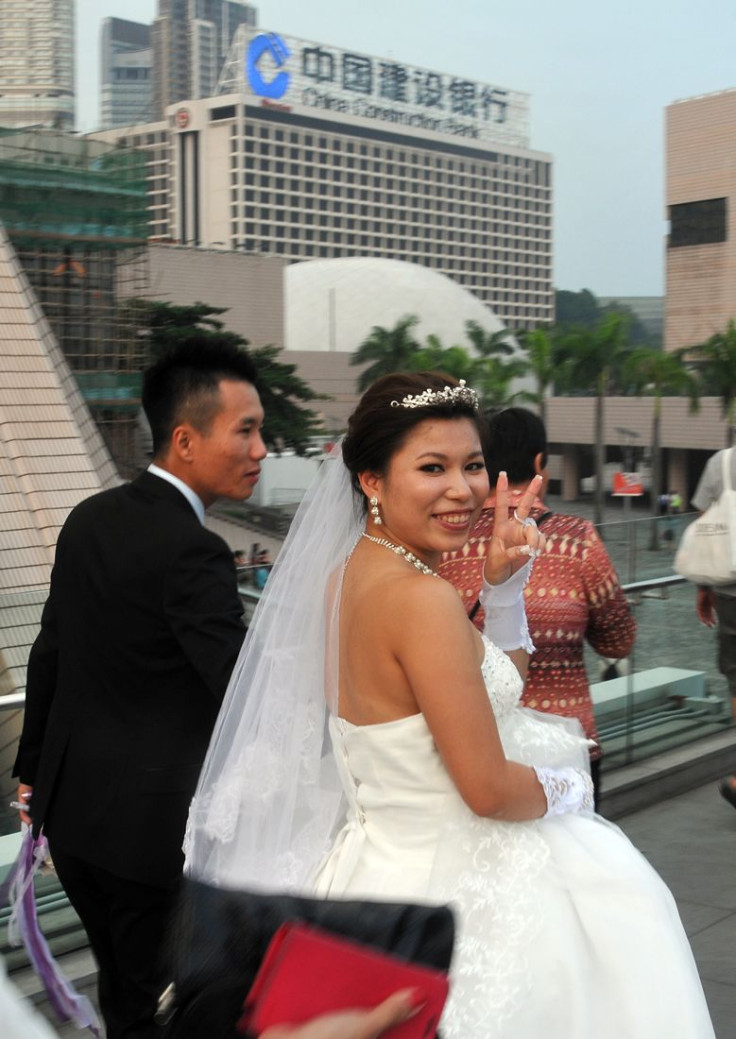
Later, on the Cathay Pacific redeye to Tokyo, I decided that, smog or not, Hong Kong's efficient public transit and its easy to reach Chek Lap Kok airport take the cake for best of the entire journey. Despite the traffic, I got around speedily and without a hitch.
On my Cathay plane's seatback entertainment system, I found a collection of old Led Zeppelin, and as I played it loud in my noise-canceling earphones (don't try this without them!) somewhere between Taipei and Okinawa, I felt like this trip had been a lot like a Zeppelin song: a furious gallop with slower moments of great beauty.
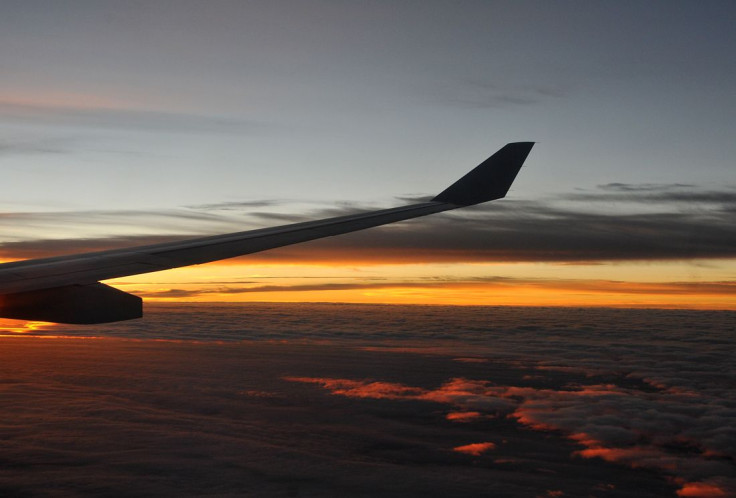
Still ahead, the longest leg of the entire trip, almost 13 hours nonstop to New York on Japan Airlines. Aviation aficionados will know that flight JL6 is far from a romantic airplane -- it's a sleek and elegant but nowadays pretty commonplace Boeing 777 series 300. But it still qualifies as a personal record: at 6,745 miles, it's the longest nonstop of my entire frequent-flier career.
Thanks to the jetstream winds blowing West to East, and so in my favor, I may even beat my scheduled landing time at JFK at 11am Wednesday -- again a touch reminiscent of Phileas Fogg, who managed to get back to London in 79 days because he gained a day by going eastbound, like I did (I won't spoil the ending for those who haven't read the book and may wonder why, then, is it called Around the World In 80 Days.)
We board in two hours. Outside, the sky is perfect light blue with perfect puffy clouds, and the end is fifteen hours away.
Day 5 - Tuesday - Dhaka to Hong Kong, China, Oct. 22
The good news first: I got to see the white whale. I crossed half the world to catch her, and she appeared where I expected, her unmistakable tail high and reflecting the setting sun. One of the only two airworthy passenger Douglas DC-10s in the world! The last tri-jet left flying in regular service from the classic age of air travel! And mine, all mine, to finally fly on!
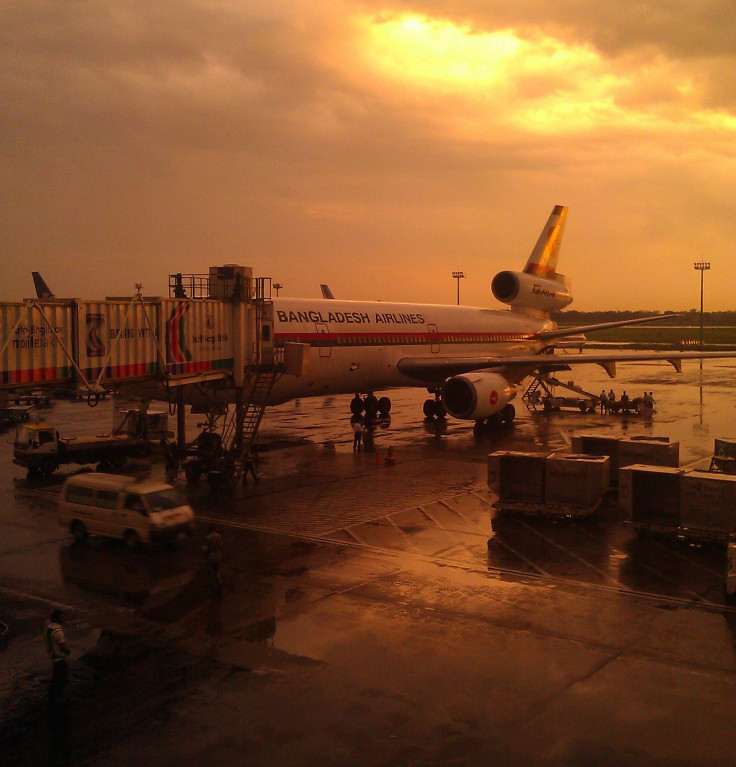
But it wasn't parked at the right gate. So this is the bad news: I did not get my first, and last, DC-10 flight. (They will be retired by the end of the year.) She was being sent on a last-minute schedule change to Saudi Arabia, to pick up people coming back from the Hadj, the pilgrimage to Mecca that is the duty of every Muslim. This year Bangladesh sent 85,000 faithful on the Hadj, and getting them there and back is not an easy feat for a cash-strapped country. So Biman is enlisted to help, and the 314 seats of the two DC-10s are just the thing to move lots of people. And that meant a downgrade of my flight to Hong Kong to a smaller Airbus 310.
Well, nothing I could do. I would at least log another first time -- I had never flown the Airbus 310, a relic from the 1980s, when the European consortium was still two decades away from sharing the market half and half with America's Boeing. Nothing short of a romantic event for someone who loves airplanes and the many stories they reveal, but still not a DC-10 ride. A sentiment shared by the three other people, one Belgian and two Japanese (men, of course, this is a pursuit nearly as gender-exclusive as the Augusta Golf Club), I had met at the gate when our dejected faces gave away to each other why we were there.
We were chatting on the plane about our globe-hopping insanity, chuckling at the improbability of it all and yet knowing it made perfect sense to us, when the intercom came on. "Inshallah, maintaining 500 knots we shall reach Hong Kong at 11 o'clock local time," announced Captain Sajjadul Haq. And God willing, as the captain said, we did. We crossed the airspace of Myanmar, entered China, flew just north of Kunming and over Guangzhou, and touched down smoothly after a pitch-dark approach over the South China Sea, with the occasional lights of ships below us. An immigration officer put a visitor stamp in my passport, my new Belgian friend and I shared a taxi and a chocolate bar along the way, and by 1 in the morning on Tuesday I was writing at my hotel in Kowloon, way past time zones to care about having to sleep.
Then early Wednesday will be another flight, from Hong Kong to Tokyo, followed by the final leg to New York after a five-hour connection. The beautiful old lady I wanted to see will be left behind, hauling her loads of devout Muslims and heavy cargo between Bangladesh and the rest of Asia, too far for me to go back before she is retired. But that isn't so bad, I thought while watching her in the golden light of Dhaka. Chasing after her took me around the world, bumping into stories I would never have told otherwise, letting me get lost for six days on end in the strange bliss of speed and altitude that you get on airplanes. That was her magic, and I did not need to touch her to feel it.
Day 4 - Monday - Dhaka, Bangladesh, October 21
What to do when you have just a few hours to try and tell some story in a city in which you have spent barely 24 hours, and whose language you completely ignore? And when you are running to get the next plane to your next stop in a journey that spans the globe in barely six days? I didn't have a lot of options to go deep in the heart of Dhaka. So on Monday morning I grabbed a camera and out I went on foot, saluted by the two Bangladeshi Army soldiers guarding my hotel, rifles held upright at their feet.
They may have been on alert for political violence. The local newspapers I read over breakfast said that there will likely be an election in late December or early January, that the political climate is heating up, and that some fear clashes ahead of the polls, although leaders are asking for calm. Bangladeshi politics is quite complex for a casual observer, and political coverage in the English-language press verges on the incomprehensible for the unititiated. But electoral posters are unmistakably electoral posters, anywhere in the world (well, the one below was easy -- it has former prime minister Khaleda Zia in the top right corner, so it’s for the opposition Bangladesh Nationalist Party, no Bengali needed to understand.)
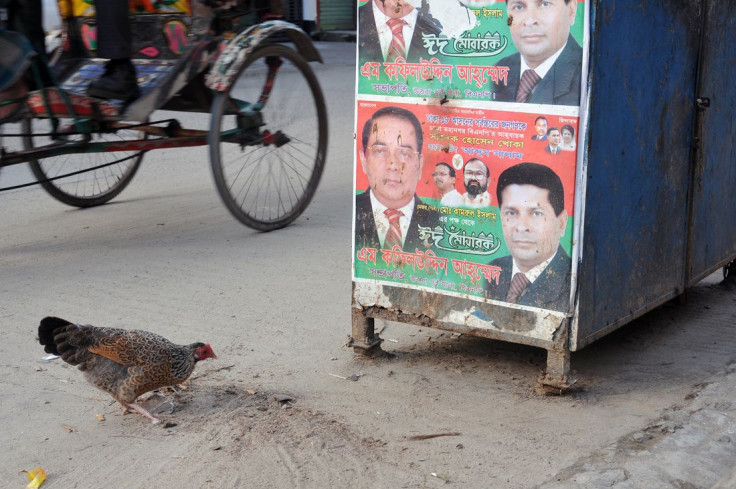
I followed for a while the chicken from the electoral poster photo -- as good a strategy as any to get somewhere in an unfamiliar city -- and got to the house where I presume she lived, with her chicks and a smiling kid.
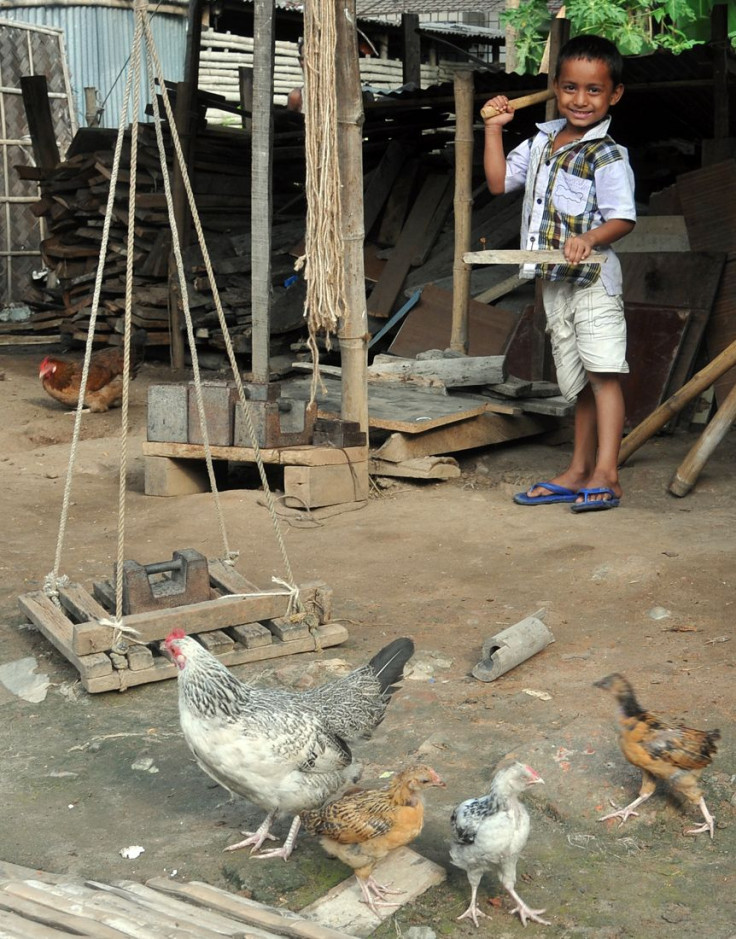
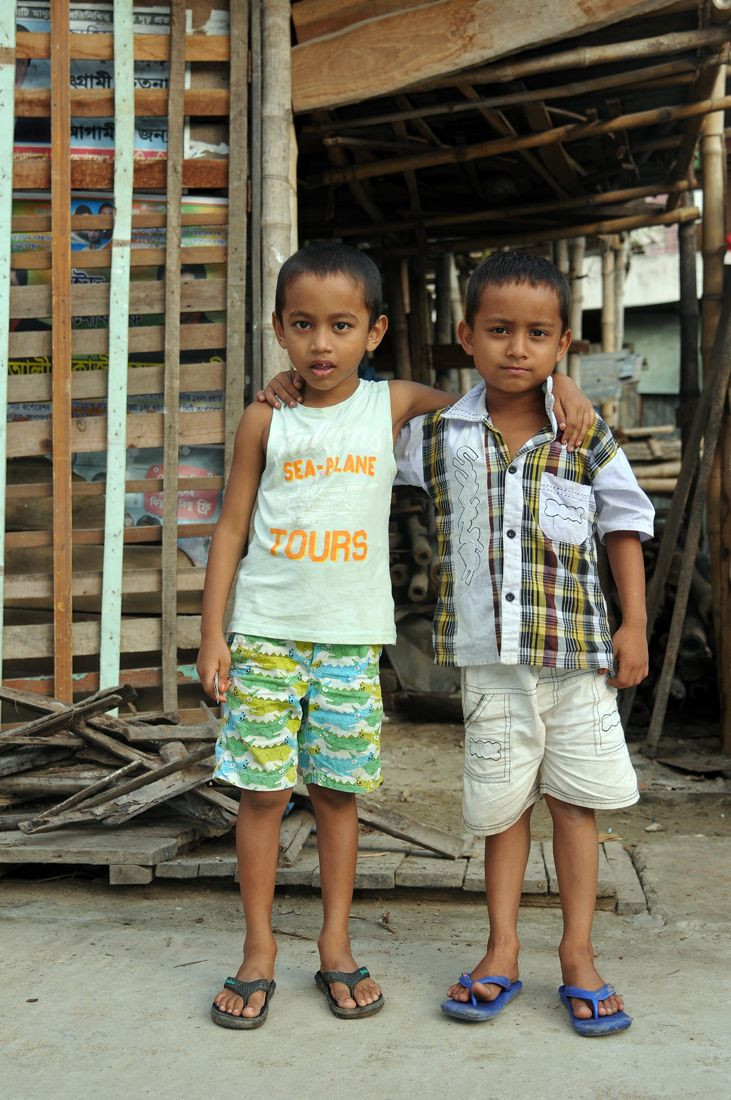
I was in Nikunja, a neighborhood probably better off than other parts of the capital; there are three-story houses with garages and new cars in them, an obvious symbol of wealth in Bangladesh. At eight in the morning, young people were going to school, and I stopped a few to ask for a quick portrait. Women, and quite a few men too, went about their morning grocery shopping at street markets.
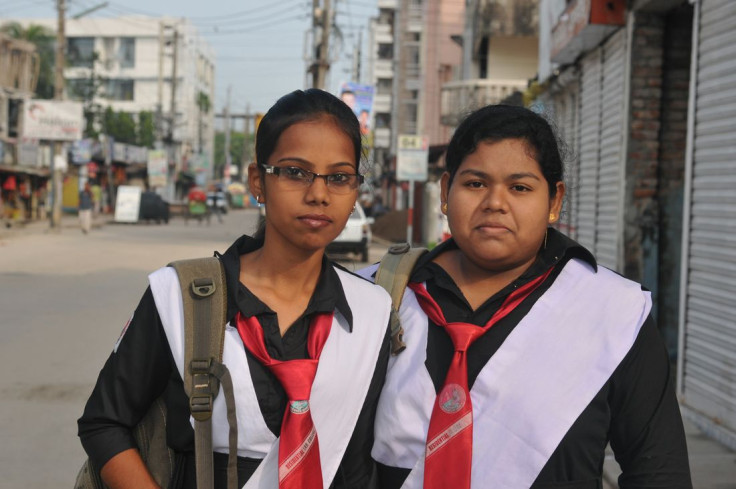

But it was the street dogs of Nikunja who stole my heart. I spent a few minutes crouching in a group of four of them, busy passersby dodging me, some stopping to smile back at me.
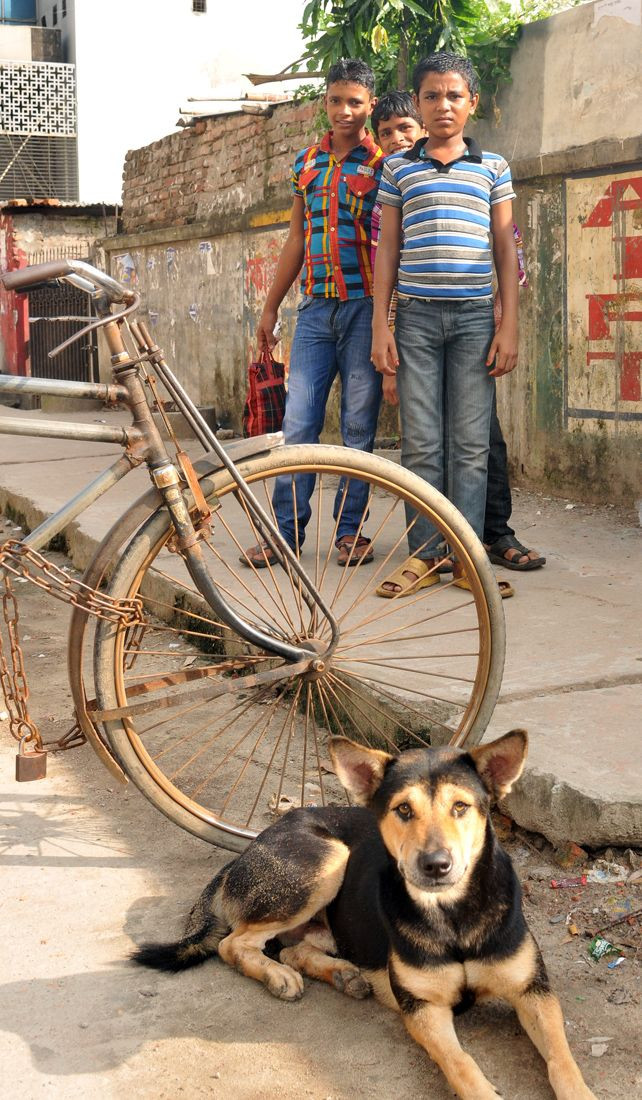

I wondered what they thought of the incessant bustle of the world's densest city around them; they seemed pretty unfazed. Which was certainly more than I could say after a day in the crazy traffic of Dhaka, the middle point of my trip around the world. Next stop: Hong Kong.
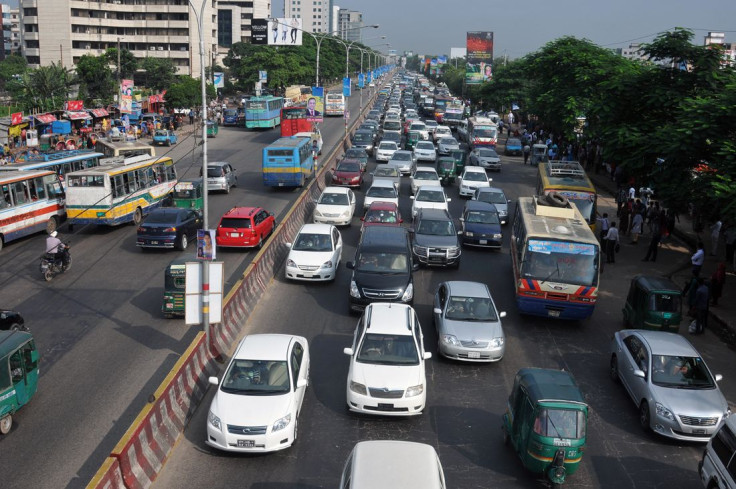
Day 3 - Sunday - Abu Dhabi, United Arab Emirates, to Dhaka, Bangladesh, October 19 / 20
First the bad news: I didn't fly the DC-10. It did not operate the Saturday night redeye from Abu Dhabi to Dhaka. I've got one chance left to fly it, on Monday to Hong Kong. But, as if to compensate, in its place Biman Bangladesh Airlines sent something I never thought I would even see, let alone travel on: a Mongolian Airlines airplane.
An exceedingly rare find among aviation connoisseurs, the Mongolian Boeing 767 has been chartered to supplement Biman's small fleet on the busy routes to the Persian Gulf -- and that's how I got to be the only Westerner on a Mongolian plane crewed by Mongolians and packed full of Bangladeshis, going from the Middle East to South Asia. Weird enough to warrant its own story.
But that's not the story I want to tell now, from a hotel room in Dhaka where a taxi driver took me after a mercifully short ride featuring the most insane driving I have ever seen. The story of today is one about being the only Western man on last night's flight, and what that brought.
The first sign that this was not going to be a flight like most others was the long, snaking line of men in the terminal Saturday evening, each one pushing a baggage cart on which they did not have suitcases but big bundles tied with twine, or overstuffed cardboard boxes. Each had their name printed on it in large, shaky capitals, plus "Abu Dhabi to Sylhet. Bangladesh." They were all men, from their twenties to their fifties, all dressed in their best. They were evidently going to be my fellow passengers on the flight to Dhaka via Sylhet, all returning home to Bangladesh after working hard in the Emirates. Waiters, construction workers, hotel employees. And I, a head taller and with a red suitcase that could not have stood out more, was the only Westerner among them.
This was terminal 2 of the Abu Dhabi airport, an ugly neon-lit affair where the airport authority concentrates the South Asian carriers. Getting to it required driving on a dark road away from the glitter and traffic at terminals one and three. The handful of flights on the departures monitors were all to Pakistan and Bangladesh. As soon as I walked through the doors a vaguely puzzled security man asked me, and me alone out of hundreds: Where are you flying to, sir?
After laboriously plowing my way through the crowd and into a check-in lane, in a chaotic jumble totally unattended by personnel, I was chatting with a man from Sylhet who had been working for thirty years in Abu Dhabi when an airport employee accosted me.
Follow me, please, sir.
Was there a problem? Not at all, he replied, I just do not want you to be in the queue with them. And he made a gesture like tying a package with twine. Then he led me to my own private check-in, with a lane opened for me and promptly closed again. Everybody else would inch painfully along for hours -- but not the only Westerner in the whole terminal! Not on his watch! Protesting that I was not entitled to special privileges would have been no use; the man might even have been offended. So I complied, and got to experience firsthand the Emirati caste system: the locals first; then the educated (and mostly white) expatriates who manage a lot of the nation's private sector; and at the bottom the vast underclass of those who actually keep the place running, but clearly are not allowed to be in the same queue as the other two.
Or even in the same seat row. When I climbed aboard I realized that he had assigned me the best seat on the plane: right by an exit, legroom for days, no one in the seat next to mine, which turned out to be the only one not occupied in coach class out of 250.
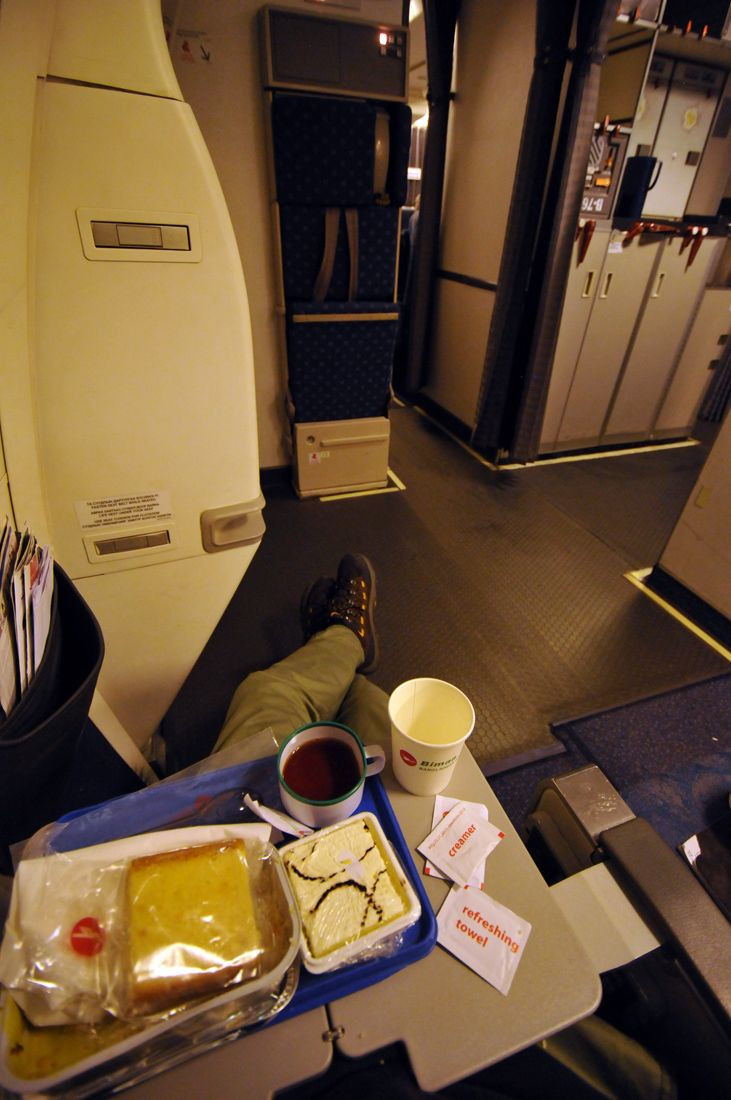
The flight was uneventful. The food was terrible. The sun rose over India.
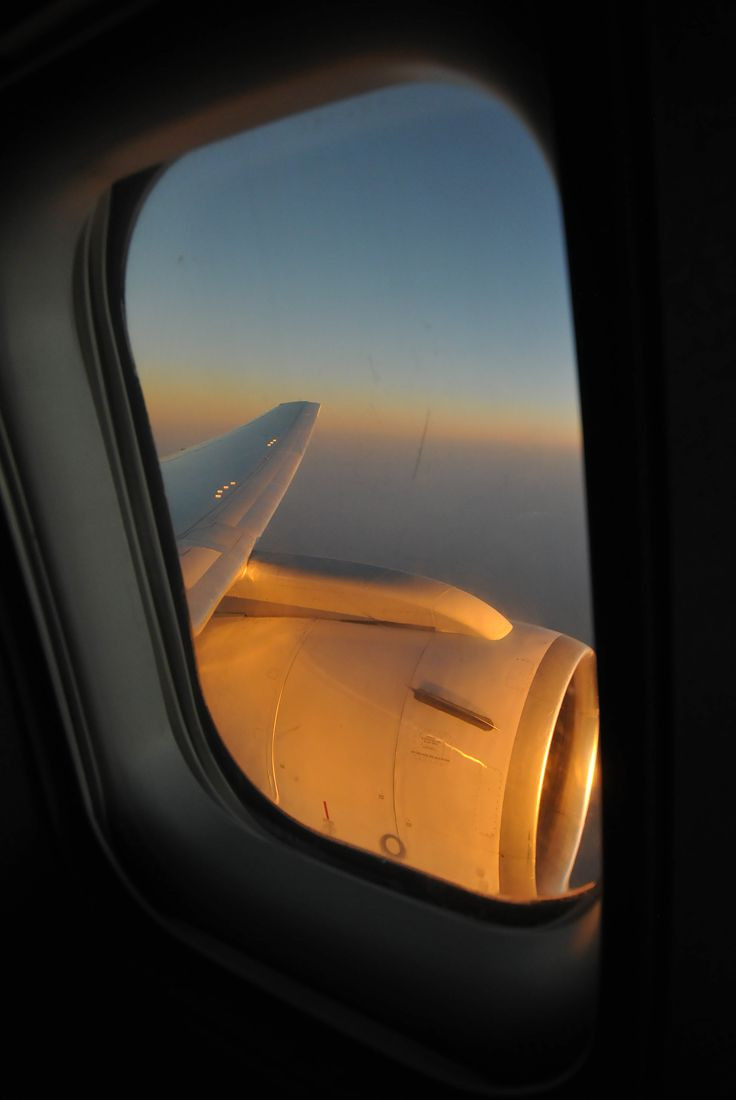
Later, waiting on the ground in Sylhet, a Bangladeshi city where most people disembarked and more came on to catch a connecting flight to London, a willowy stewardess from the Mongolian crew (who would only bark monosyllables at the other passengers) asked me where I was headed, and smiled at the story of my round-the-world race. "Very nice," she said in halting English, "I love travel".
She would have three days' rest on the ground in Dhaka before flying back to Abu Dhabi or Riyadh with her crew; that was their contract with Biman, going only to those two cities and getting a long rest after every flight. I envied her luxury. I would spend a little more than 24 hours in the capital of Bangladesh -- and to try and see some of it, tonight I'll head to downtown Dhaka. On Monday I will be off to Hong Kong, for the last chance to find my elusive prey, the DC-10.
(And because this is after all a trip dedicated mostly to indulging my love of civil aviation, I asked that stewardess if I could take a peek into the flight deck, and here's what it looked like. The Mongolian first officer, unfamiliar with Sylhet, had a map of the airport clipped on to his control yoke.)
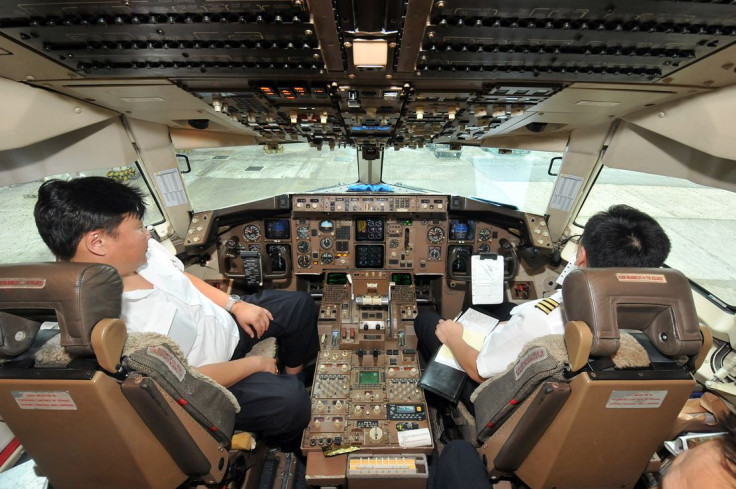
Day 2 - Saturday - Abu Dhabi, United Arab Emirates, October 19
It's Saturday afternoon in Abu Dhabi -- or rather in Gate City, a new development on the outskirts of the second-biggest city in the United Arab Emirates, where I am stopping briefly on the way to Dhaka and to the legendary airplane I'm chasing, the last Douglas DC-10. I arrived early this morning on Etihad Airways from London, after crossing Europe diagonally from the Belgian coast to the Black Sea, then Turkey, Iraq and the Gulf (and maybe even a slice of Iran, but the in-flight map did not have political borders.) The sun set to our right on Friday while dinner was served over the Hungarian plain.
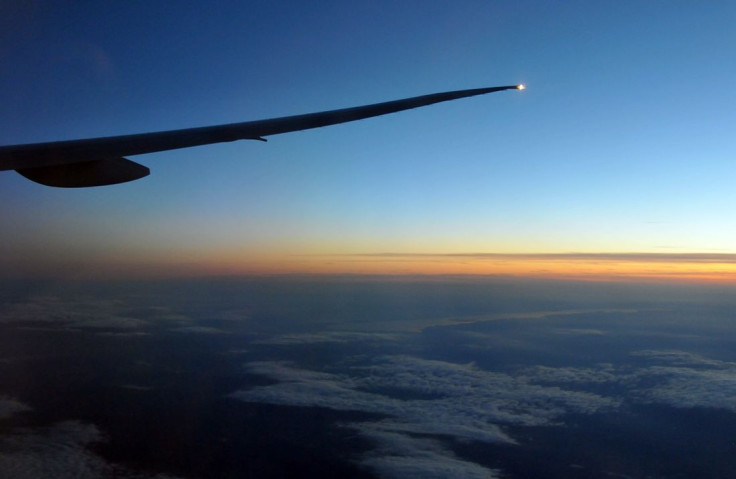
I'm not even 36 hours out of New York, and already this globe-trotting jaunt is reminding of the Jules Verne novel that has inspired travelers since the 1870s. Specifically I'm thinking of the part where Verne describes his hero Phileas Fogg as utterly unconcerned with his surroundings, while he crosses the world in 80 days: "As for visiting the city, he wasn't even thinking of it, being one of those Englishmen who have their domestics visit the cities they traverse."
Now, I would love to go see Abu Dhabi, whose skyscrapers shimmer in the distance like desert mirages (also, I certainly do not have a butler like Fogg to send in my place for errands). But I arrived at the hotel at 3 o'clock in the morning today, woke up at 1 p.m. after the first sleep I got since Thursday morning, and I have a flight to catch tonight. No time for sightseeing. I'm going to just have to photograph the city from my room on the ninth floor of the Novotel.
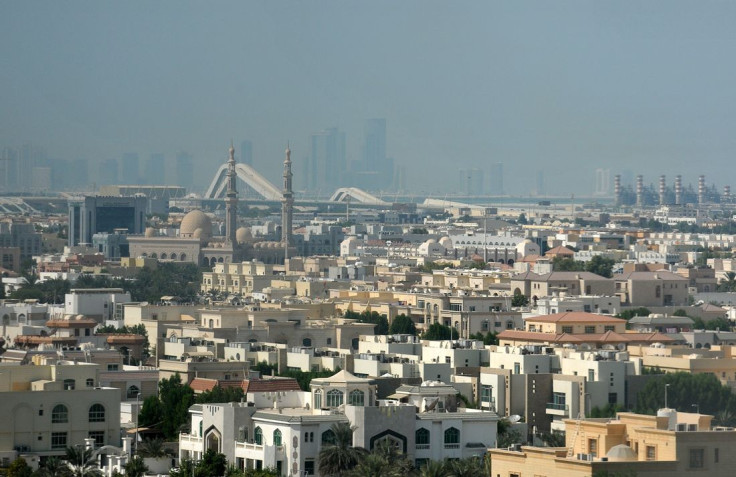
I'll be back in the Emirates next month for the Dubai Air Salon, and then I'll have more time to explore the strange new cities on the Persian Gulf (but don't call it that in Abu Dhabi! That's what the Iranians say. Here on the Arab side, it's the Arab Gulf. Or, diplomatically, just "The Gulf", al-khaleej: see the masthead of the local newspaper that I'm reading by the hotel pool.)

In the short time I have been here, I realized one thing: probably no place on Earth has ever changed so much, so fast as the Emirates. My Lonely Planet guidebook to the Arab Gulf States is from 1996. It features on the cover a photograph of a fishing dhow and some ruins -- but 17 years later, things are very different. This book is ridiculously out of date, like a guide to modern-day Manhattan with Algonquin Indians and Dutch windmills on the cover.
I had listened to friends and colleagues describe, in awed or disgusted terms, the Las Vegas quality of the newly rich Emirates. I had seen young investment bankers leave London and New York for the golden promise of the East, or just to escape layoffs in the West ("Dubai, Mumbai, Shanghai, or goodbye," went the sad refrain at the height of the crisis.) But seen on the ground, it really does feel uniquely weird. The Western culture of consumption and entertainment has won by default, and its juxtaposition with local customs is where the uncanny feeling comes from.
At the airport, women entirely covered in abayas flashed Cartier gold watches, when a long black sleeve revealed a wrist; their husbands and children looked straight out of top-end American shopping mall ads. The taxi ride last night could have been in Florida: just change the Arabic signs on the perfectly maintained, palm-lined highway, and it's Ft. Lauderdale with minarets. And as I write this, the muezzin from a nearby mosque has just finished his melodious call to afternoon prayer. But at the pool where I'm sitting, the Arab women lounging in bikinis and the German kids splashing noisily in the pool all but ignored him. No one even raised an eyebrow.
On the horizon, giant Etihad jets take off from the Abu Dhabi airport. That's where I'm headed tonight, I hope for the first encounter with the white whale I am after: one of the two DC-10s left flying passengers in the world. But Biman Bangladesh Airlines is known for substituting boring, ordinary planes for their DC-10s at the last minute, so I'll need to be lucky. In any case, tomorrow morning I will be in Dhaka, and in for a radically different experience in one of the most crowded metropolises in the world.
Day 1 - Friday - London, Heathrow Airport, October 18
The tacky British-flavored bric-a-brac I snapped with my phone could be anywhere -- just substitute a Stars and Stripes for the Union Jack, replace the ubiquitous "Keep Calm And Carry On" with some inspiring American-themed quote, maybe throw in a Statue of Liberty, and presto: you are back on the other side of the Atlantic. Oh, and the screaming children. Those are exactly the same in every airport.

I'm not getting to see London this time: my connection to Abu Dhabi departs in two hours. I have a total of four hours on the ground here, between a Virgin Atlantic flight from JFK and a connection on Etihad Airways, one of the new breed of Persian Gulf airlines that have stunned the airline industry by growing in a decade into giants that threaten the old Western flag carriers.
But even without seeing the city, I'm getting a whiff of its cosmopolitan flavor. Many of the voices of the other passengers around me are Russian. The woman who went through my camera bag at the security check wore a hijab and looked South Asian. The man who checked my boarding pass when transfering terminals could have been Malay or Indonesian. The tour group to my right with a loud guide is Chinese, but the smaller one behind me is from Japan. And among the yellow-jacketed airport workers swarming ceaselessly, the most common accent is unmistakable London.
This may be the sterile, globalized world of airports, sure, but if you look out the window before landing, there is no doubt you are under the overcast sky and looking at the green fields of England.

The original story is below.
Phileas Fogg did it in 80 days. I plan to go around the world in less than a week, and chronicle the trip as I go. But unlike the protagonist of Jules Verne's Around The World In 80 Days, I have something at my disposal that the London gentleman did not have one hundred and forty-one years ago: jet airplanes. As a matter of fact, a jet airplane is precisely the reason I am going around the globe, following more or less the same route Fogg took from October 2 to December 21, 1872.
The airplane I am after is one of the last two Douglas DC-10 left in the world today in passenger service, and I want to fly on one before they are retired for good at the end of this year. Both of them can be found in Dhaka, the capital of Bangladesh, hauling people around Asia under the colors of Biman, that country's flag-carrier airline. If you are an aviation aficionado who grew up in the 1970s dreaming of flying one day across continents on one of those big jets, reading the air-mail letters your father sent you from exotic destinations where a DC-10 had just taken him on a business trip, this is really your last chance to see the inside of a classic Douglas long-ranger from that era. And while plotting my itinerary, jumping from Google Maps to airline websites to the online forums where airplane geeks were excitedly making plans to be on the last DC-10, I realized that once you've made it to Bangladesh from New York, you might as well go round the globe. A few clicks later, I had my plan. I will fly to Abu Dhabi via London to jump on a Biman DC-10 to Dhaka, sharing the flight with hundreds of Bangladeshi emigrant workers returning home with the money they earned building the gilded skyscrapers of the new, hyperwealthy Persian Gulf.
Then I will go on to Hong Kong on the other Biman DC-10, enjoying -- or so I hope -- a flight that my fellow plane devotees say is always empty, and possibly access to the cockpit during flight. (Biman captains are apparently used to Western plane-crazies going all the way to Bangladesh just to set foot on a 40-year old flying machine, and they are more than willing to let them ride up front.) From there I will return to the States via Tokyo, logging a few thousand more miles to my account and landing at JFK five days and 12 hours after starting off, thanks to the crossing of the international date line over the Pacific that will result in a net gain of one day and put me in New York one hour before leaving Japan on a 13-hour nonstop flight.
Along the way I'll leave the self-contained world of airports and airlines -- the location-less parallel universe that Walter Kirn called "Airworld" in his novel Up In The Air -- in Abu Dhabi, Dhaka and Hong Kong. I will have just enough time to get a quick hit of what it's like to be there, and to experience the dizziness of extreme jet lag while enjoying the clarity of thought that comes when uprooted and at the mercy of an airline's schedule. Doing this in 2013 costs less than in 1872, by the way. A lot less. Shopping around (and flying strictly coach class) limited my expense for flights and hotels to $2,500 -- a screaming bargain compared to the 20,000 British pounds Fogg had to shell out in his day. After accounting for 140 years of inflation plus today's exchange rate, it turns out that going around the world cost him the equivalent of 2.4 million dollars. Granted, he had to hire an elephant and post bail to get out of prison in India, and face other unforeseen costs like buying a ship from its owner in order to get across the Atlantic on schedule.
All the same, I'm still doing what he did in one-sixteenth of the time and spending one-thousandth of the money. So, three cheers for the (relatively) cheap movement of people and goods. Follow me on Twitter and here to come along on a six-day sprint across the Earth.
© Copyright IBTimes 2024. All rights reserved.






















